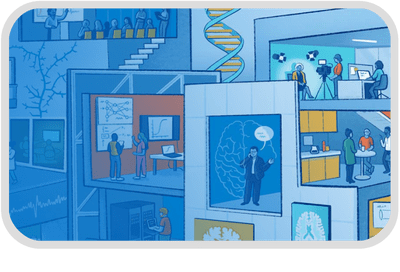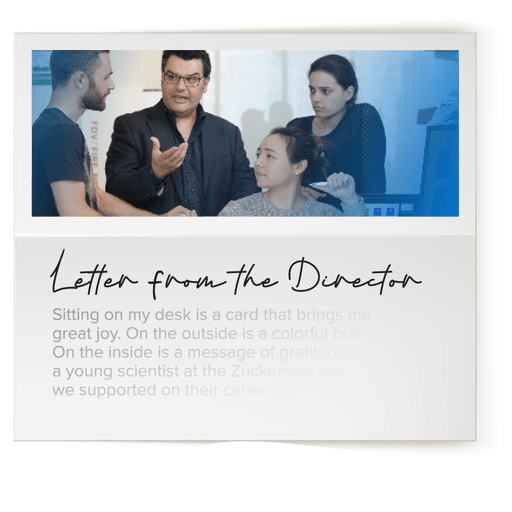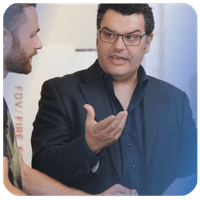Sitting on my desk is a card that brings me great joy. On the outside is a colorful brain. On the inside is a message of gratitude from a young scientist at the Zuckerman Institute we supported on their career path.
Our institute aims to be a place where we invest not just in science, but in people. As I look at where we stand today, I am proud of what we have achieved so far, humbled by how much more we can do and excited for our future.
When I became director and CEO of this institute, we were already doing transformative science. That research has continued to develop, thanks in part to a campaign that brought in nearly $150 million from donors who recognize the importance of fundamental neuroscience. Last year alone we published 153 papers, many in the world's most influential journals.
As our science has evolved, so too has our culture. Look at our theorists, some of the best in the world. These experts in mathematical modeling have fostered collaborations across our labs. About one out of every five papers published here now features a partnership between a theorist and a neuroscientist doing experiments at the lab bench.
We have also begun to build a powerful training program for our early career researchers, from workshops and one-on-one grant assistance to opportunities for networking and growing leadership skills. Over the past four years our trainees were awarded 22 K99 grants from the NIH, intended to provide postdocs with a pathway to independence — an incredible feat for a research institute our size.
We have been doing the hard and vital work of talking about systemic bias and racism, guided by our Diversity, Equity, Inclusion and Belonging (DEIB) Board and our scholar-in-residence, who is an expert in bias reduction training. Our new hires, from principal investigators to a senior director of DEIB, reflect our commitment to fostering diversity.
Our work is far from done. I’ve heard those saying we can do more to improve mentorship and support our early career scientists. I’ve heard those saying we can do more to bring people together and build bridges. But we have begun a collective movement.
As I look back on my time here, I am reminded of a Friday night in March of 2020, a Zoom call with more than 50 people from our institute. It was the early days of the pandemic, and I was leading the university's response. This group of scientists and administrators had come together to talk about designing an at-home COVID test and a chamber for more safely intubating patients.
Even in that moment of great darkness, I felt an immense sense of connection, of unity, stretching across every corner of our community. I saw what we can be, what I believe we're heading toward. The Zuckerman Institute belongs to everyone here. As our leadership transitions this year, we will continue the work of shaping it with the future in mind.
Rui Costa
Sitting on my desk is a card that brings me great joy. On the outside is a colorful brain. On the inside is a message of gratitude from a young scientist at the Zuckerman Institute we supported on their career path.
Our institute aims to be a place where we invest not just in science, but in people. As I look at where we stand today, I am proud of what we have achieved so far, humbled by how much more we can do and excited for our future.
When I became director and CEO of this institute, we were already doing transformative science. That research has continued to develop, thanks in part to a campaign that brought in nearly $150 million from donors who recognize the importance of fundamental neuroscience. Last year alone we published 153 papers, many in the world's most influential journals.
As our science has evolved, so too has our culture. Look at our theorists, some of the best in the world. These experts in mathematical modeling have fostered collaborations across our labs. About one out of every five papers published here now features a partnership between a theorist and a neuroscientist doing experiments at the lab bench.
We have also begun to build a powerful training program for our early career researchers, from workshops and one-on-one grant assistance to opportunities for networking and growing leadership skills. Over the past four years our trainees were awarded 22 K99 grants from the NIH, intended to provide postdocs with a pathway to independence — an incredible feat for a research institute our size.
We have been doing the hard and vital work of talking about systemic bias and racism, guided by our Diversity, Equity, Inclusion and Belonging (DEIB) Board and our scholar-in-residence, who is an expert in bias reduction training. Our new hires, from principal investigators to a senior director of DEIB, reflect our commitment to fostering diversity.
Our work is far from done. I’ve heard those saying we can do more to improve mentorship and support our early career scientists. I’ve heard those saying we can do more to bring people together and build bridges. But we have begun a collective movement.
As I look back on my time here, I am reminded of a Friday night in March of 2020, a Zoom call with more than 50 people from our institute. It was the early days of the pandemic, and I was leading the university's response. This group of scientists and administrators had come together to talk about designing an at-home COVID test and a chamber for more safely intubating patients.
Even in that moment of great darkness, I felt an immense sense of connection, of unity, stretching across every corner of our community. I saw what we can be, what I believe we're heading toward. The Zuckerman Institute belongs to everyone here. As our leadership transitions this year, we will continue the work of shaping it with the future in mind.
Rui Costa
Sitting on my desk is a card that brings me great joy. On the outside is a colorful brain. On the inside is a message of gratitude from a young scientist at the Zuckerman Institute we supported on their career path.
Our institute aims to be a place where we invest not just in science, but in people. As I look at where we stand today, I am proud of what we have achieved so far, humbled by how much more we can do and excited for our future.
When I became director and CEO of this institute, we were already doing transformative science. That research has continued to develop, thanks in part to a campaign that brought in nearly $150 million from donors who recognize the importance of fundamental neuroscience. Last year alone we published 153 papers, many in the world's most influential journals.
As our science has evolved, so too has our culture. Look at our theorists, some of the best in the world. These experts in mathematical modeling have fostered collaborations across our labs. About one out of every five papers published here now features a partnership between a theorist and a neuroscientist doing experiments at the lab bench.
We have also begun to build a powerful training program for our early career researchers, from workshops and one-on-one grant assistance to opportunities for networking and growing leadership skills. Over the past four years our trainees were awarded 20 K99 grants from the NIH, intended to provide postdocs with a pathway to independence — an incredible feat for a research institute our size.
We have been doing the hard and vital work of talking about systemic bias and racism, guided by our Diversity, Equity, Inclusion and Belonging (DEIB) Board and our scholar-in-residence, who is an expert in bias reduction training. Our new hires, from principal investigators to a senior director of DEIB, reflect our commitment to fostering diversity.
Our work is far from done. I’ve heard those saying we can do more to improve mentorship and support our early career scientists. I’ve heard those saying we can do more to bring people together and build bridges. But we have begun a collective movement.
As I look back on my time here, I am reminded of a Friday night in March of 2020, a Zoom call with more than 50 people from our institute. It was the early days of the pandemic, and I was leading the university's response. This group of scientists and administrators had come together to talk about designing an at-home COVID test and a chamber for more safely intubating patients.
Even in that moment of great darkness, I felt an immense sense of connection, of unity, stretching across every corner of our community. I saw what we can be, what I believe we're heading toward. The Zuckerman Institute belongs to everyone here. As our leadership transitions this year, we will continue the work of shaping it with the future in mind.
Rui Costa




THE FUTURE IN
MIND
©2022 The Zuckerman Institute, Columbia University
©2022 The Zuckerman Institute, Columbia University


